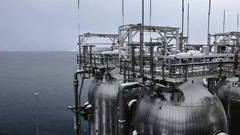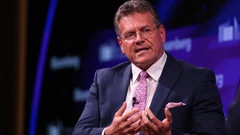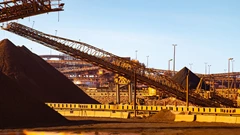Europe Gas Edges Higher as Traders Assess Winter Supply Outlook
(Bloomberg) -- European natural gas prices nudged higher as traders assess risks to winter supplies and uncertainty over demand in the heating season.
Benchmark futures gained 0.6% after earlier sliding as much as 2.2%. Prices added almost 11% on the week, the biggest such advance since early August. Futures for October delivery expired Friday.
“There is again so much uncertainty about this winter,” said Florence Schmit, energy strategist at Rabobank. “How strong will demand turn out to be, how much gas will actually flow through Ukraine and what if Asia experiences a similar demand growth?”
Traders are awaiting clarification on whether gas will continue to cross Ukraine toward central Europe after a transit deal between Moscow and Kyiv expires at the end of the year. Those flows mainly serve Austria and Slovakia. “If there is a new transit agreement and the weather does not get as cold as currently forecast then the market moves quickly in the opposite direction,” Schmit said.

Various options are on the table for transit. One would bring in Azerbaijan’s Socar to ship the fuel via Ukraine, according to Slovak gas provider Slovensky Plynarensky Priemysel AS. SPP is seeking partners to keep the gas coming, Chief Executive Officer Vojtech Ferencz said in an interview Thursday.
There’s no guarantee that an agreement will be reached. One obstacle may be that any continuation of Russian gas flows to the European Union — which has distanced itself from talks — may not be politically acceptable to the bloc.
“While we regard a gas-swap deal between Russia and Azerbaijan as a much-welcomed initiative, the possibility of continued flows hinges upon the willingness of the EU to assume reputational risk,” Christoph Halser, an analyst at Rystad Energy, said in a note.
Regional industrial users hope that transit will continue to ensure competitive supplies for their factories.
“The cheapest way to get the natural gas to East Slovakia is from east through the Ukrainian border,” said Miroslav Kiral’Varga, vice president at US Steel Kosice, whose plant accounts for about 5% of the nation’s industrial demand for gas, said in an interview.
Heating Season, LNG
The market remains on alert for other bullish factors. A brief cold spell forecast for the start of October is set to curb gas injections into storage sites. Rystad has increased its near-term consumption forecasts, citing likely demand for heating in countries including Germany.
On the supply side, outages at Norwegian facilities continue. Most of the annual maintenance stoppages are concluding, though some have faced delays.
Attention is also on liquefied natural gas imports for this winter and potential competition with other regions for cargoes. Europe increasingly depends on supplies from global production plants. Outages at such facilities can send European gas prices rising.
In the US, Kinder Morgan is in the process of resuming operations at its Elba LNG export facility near Savannah, Georgia, on Friday following power outages at the site in the wake of Hurricane Helene.
Dutch front-month futures, Europe’s gas benchmark, settled at €38.11 a megawatt-hour in Amsterdam.
©2024 Bloomberg L.P.
KEEPING THE ENERGY INDUSTRY CONNECTED
Subscribe to our newsletter and get the best of Energy Connects directly to your inbox each week.
By subscribing, you agree to the processing of your personal data by dmg events as described in the Privacy Policy.
More gas & LNG news

ADNOC successfully completes $2.84 billion marketed offering of ADNOC Gas shares

Scientists Say EU Carbon Market Should Include Removals Like CCS

Trump Will Allow for More Gas Pipe Expansion, Southern CEO Says

EU Trade Chief Says Ready to Work With US on Lower Tariffs

EU to Look at More ‘Flexible’ Filling of Gas Storage Post-2025

bp begins production from Raven Phase 2, offshore Egypt

Diamondback Nears Permian Deal to Buy Shale Producer Double Eagle

Australia’s Iron Ore Hub Reopens, Rio Mines Resume After Cyclone

Australia’s Iron Ore Export Hub to Reopen After Cyclone Weakens
















